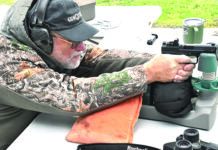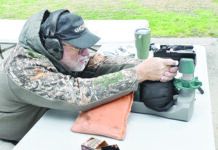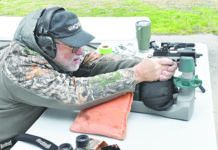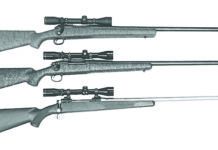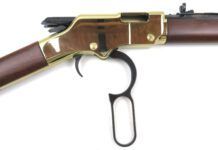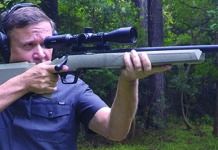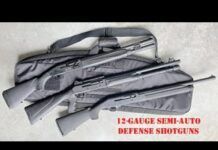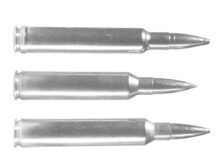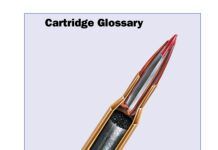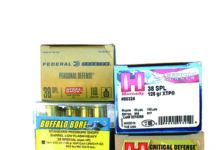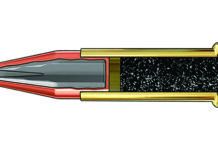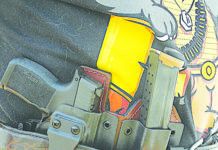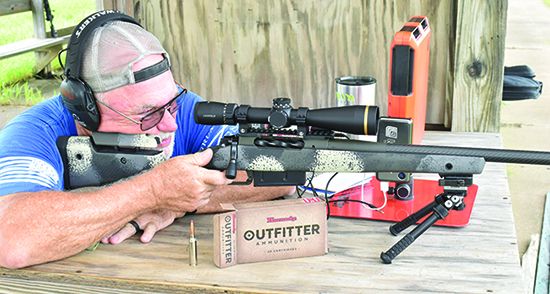
In the November 2023 issue, we checked out three great hunting rifles chambered in 7 PRC. The Christensen Arms, Mossberg, and Remington rifles we tested were great for hunting, but we wanted something a bit heavier and with a muzzle brake to try targets out to a mile. This time we grabbed two rifles that came with what we thought were the necessary bells and whistles.
The first was the Springfield Armory Waypoint 2020. The short-action version has been on the market for almost four years. A model with an action long enough to handle the full-length 7 PRC cartridge (BAW9247PRCCFGA, $2289) sports a 24-inch barrel, carbon-fiber-wrapped barrel complete with a good radial muzzle brake and a stock made by AG Composites. We also had some experience with the Christensen Arms Modern Precision Rifle (801-03016-00, $2499) that we felt would meet the necessary criteria. Our MPR also came with a carbon-fiber-wrapped barrel, though this one is of Christensen Arms’ own design topped by a 12-port muzzle brake. It also includes a folding chassis to make it a little easier to transport. Both use Remington 700-pattern receivers, so accessorizing your rifle is a snap.
How We Tested
So much of our interest in this project started with an opportunity to shoot at a target a mile away. Like many bucket-list items, we got our chance, succeeded in a minor way, learned things, and want to be prepared when we got to do it again. We wanted a longer barrel to milk all the velocity we could. We wanted a muzzle brake so we could see hits or misses in the scope during recoil. And we needed positive personal aspects in the rifle, such as an adjustable cheek piece to line us up perfectly behind the scope; a vertical pistol grip to help our hands work with the trigger in the positional shooting; and an adjustable length of pull to help us with our form and recoil control. We also needed a great trigger.
Our first attempts at mile-long shots came with 6.5 PRC rounds, but we realized we also needed a better cartridge. Our 6.5 PRC just ran out of ability to buck the wind past about 1500 yards. The Applied Ballistics Mobile app we use shows that the 7 PRC will get to a mile still retaining about 130 fps over the 6.5 PRC, and the 7 PRC actually has better long-range ballistics than most 300 Win. Mags or even the 300 PRC.
We tested at American Shooting Centers in Houston, firing multiple three-shot groups at 100 yards supported by an Atlas Bipod (BT46-LW17 PSR). Then we added the BTCA adapter from Really Right Stuff, which allowed the quick-release clamp to work with Picatinny or Arca Swiss rails. There is nothing cheap about the bipod in function or price, with total cost running close to $600. The rifles were further supported by a large rear bag, heavy from Tab Gear.
Most of the ammunition available at the time of this writing was from Hornady. Since that company developed the cartridge, we thought they were a pretty good choice. We tested using their Outfitter load using 160-grain CX (Copper alloy eXpanding) bullets along with Precision Hunter rounds loaded with the 175-grain ELD-X (Extremely Low Drag – eXpanding) bullet as well as the Match ELD-M rounds loaded with 180-grain match bullets. We also included a heavier load we developed for a personal 7mm PRC that used Berger 195-grain EOL Elite Hunter bullets (#807744, MidwayUSA.com) loaded on top of Vihta Vuori N565 powder and Federal Gold Medal Match Large Rifle primers. We used reloading data provided by Berger bullets and stayed strictly within their limits.
We used two optics from Leupold for our testing at 100 yards. The first was the outstanding MK5 HD 5-25×56 riflescope with the PR2-mil reticle (180222, $2199). The second scope was the VX-6HD 3-18×44 model (171565, $1899), which came with a duplex reticle illuminated with the FireDot system. The CDS-ZL2 turrets were set for quarter-minute-of-angle adjustments. A top range of 18x magnification was more than sufficient for 600-yard shooting, so we placed both scopes at that power for the entire test. Here’s how the rifles performed:
Springfield Armory Waypoint 2020 BAW9247PRCCFGA,
$2289
Gun Tests grade: A- [our pick]
This Waypoint 2020 easily beat Springfield’s sub-0.75-MOA pledge. Being extremely picky, we would like to see an adjustable length of pull and a magazine release that was a bit easier to depress.


| Action Type | Bolt |
| Overall Length | 45.9 in. |
| Barrel Length/Twist | 24.0 in., 1:8 twist |
| Overall Height w/o Scope Mount | 6.0 in. |
| Weight Unloaded | 7.91 lbs. |
| Weight Loaded | 8.44 lbs. |
| Action Finish | Green Cerakote |
| Barrel Finish | Carbon fiber, black Cerakote |
| Magazine Capacity | 3 rounds |
| Magazine Type | Accumag detachable box |
| Stock | Carbon fiber |
| Stock Drop at Comb | Adjustable |
| Stock Drop at Heel | Adjustable |
| Stock Bedding | Pillar |
| Stock Buttplate | Rubber |
| Stock Length of Pull | 13.8 in. |
| Receiver Scope-Base Pattern | Picatinny rail, 20 MOA |
| Trigger Pull Weight | 1.65 lbs. |
| Safety | Two-position thumb rocker |
| Warranty | Limited lifetime for original owner |
| Telephone | (800) 680-6866 |
| Website | Springfield-Armory.com |
| Made In | U.S. |
Well known for well-made 1911s, polymer pistols, and semi-auto rifles, Springfield Armory jumped in the bolt-action game in 2020 with the Waypoint rifle. Featuring great composite stocks, standard metal or carbon-fiber-wrapped barrels, Trigger Tech triggers, and a Springfield Armory action, Springfield swung for the fences their first time at bat. The early offerings were all short actions and were chambered in 6.5 Creedmoor, 308 Winchester, 6.5 PRC, and then 6 Creedmoor. We’ve tested the 6.5 CM and 6.5 PRC versions in the past (see the June 2023 and April 2024 issues) to very good reviews. Our test rifles have shot very well and run reliably.
With that history, we recently noticed that Springfield was offering the Model 2020 Waypoint in a long action, and we had to check it out. The longer receiver allows Springfield to chamber long cartridges, and the staff selected some great ones for the early production runs. The long-action Waypoint is available in 300 Win. Mag., 300 PRC, 7mm Rem. Mag., and 7 PRC.
Springfield’s shooters put a lot of their own ideas and features into this new rifle, but they didn’t try to completely reinvent the wheel. We’ve seen any number of manufacturers recently stay with an existing design for their action. That simplifies engineering and really adds to the aftermarket parts tail for their products. While Savage offers a great action for this purpose, the most commonly chosen footprint seems to be the Remington 700. The cylindrical 700 design eases production issues somewhat, and quality parts like triggers or scope mounts already abound.
The receiver for the new Waypoint 2020 long action looks a lot like the short-action version. The bridge above the ejection port is open, but still has a lot of stainless steel around the sides. Using a port that was designed to allow the ejection of a 300 PRC leaves plenty of room for the shorter 7 PRC to eject cleanly. Anyone who wants to reload for this rifle will have plenty of clearance to seat their bullets long. Everything (action and metal parts of the barrel) is coated with H264 Mil-Spec Green Cerakote. The top of the receiver is drilled and tapped for 6-48 screws in the Remington 700 pattern, and it comes with a 20-MOA Picatinny rial installed.
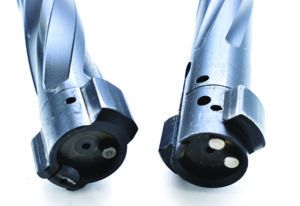
Springfield used many of the controls we are accustomed to and changed others for the better. The manual safety is a two-position thumb-rocker type on the right side, as we would expect. A cocking indicator protrudes from the bolt shroud, and the bolt handle is oversized and easy to operate. The fluted bolt body utilizes two opposing lugs, a plunger-style ejector, and a sliding-plate extractor. The three-round Accumag releases by the shooter pressing a tab low and forward in the trigger guard. We found the best technique was to rest the rifle on the bipod or a bag, depress the mag release with one thumb while drawing down on the snugly fit magazine with the other hand. The Accumag that shipped with our unit was marked as being built for the 300 Win. Mag. cartridge and had a maximum overall length of 3.85 inches. Our 7 PRC loads had a max OAL of 3.34 inches, so there was lots of room there as well. Springfield modified the bolt release to a stronger unit (than a Remington) that is removed via a lever on the left side of the receiver. Then Springfield selected the excellent Trigger Tech Field trigger. Rated for pull weights ranging from 2.5 to 5 pounds, ours did a bit better, averaging a crisp 1.65 pounds over ten pulls on our Lyman digital scale.
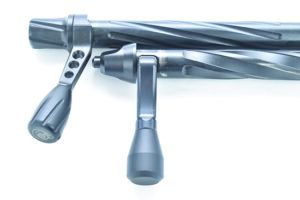
Many carbon-fiber-barreled rifles use a traditional wrap around the metal barrel. The fiber adds rigidity, while allowing a thinner barrel. The combination brings weight down, and it does seem to bring a thermal advantage. The Waypoints use a BSF-brand barrel with a slightly different system. They take a stainless-steel tube and flute it longitudinally before applying the carbon-fiber wrap. With their method, the fiber only contacts about 5% of the barrel steel. The concept is to leave a channel that stays rigid while it aids cooling. The muzzle was threaded 5⁄8×24 and came with a radial muzzle brake installed. A thread protector was also enclosed.
The stock was made by AG Composites. Constructed from a proprietary material, these stocks are CAD designed and CNC machined. This piece had just enough room left to slide a business card between the barrel and the stock. Tight, but not too tight. There are two QD cups, one on each side of the forend and two more opposing cups near the recoil pad. A fifth is located on the bottom of the buttstock. The rifle is thus set up to carry easily on either side or conventionally over the shoulder. The bottom of the forend displays some nice sculpting, with a flat surface near the magazine and a more rounded surface toward the muzzle. The forward part also has three M-Lok slots, into which we promptly mounted a section of Picatinny rail for our bipod. The bottom of the buttstock even has a flat bottom to help ride solidly on a bag.
The pistol grip is almost vertical, which helped us with the positional shooting. It had a nice palm swell, which made it easier for us to repeat our hand position for the strong-side thumb grip we use. The stock also has an adjustable cheek piece tailor made for some of these big-belled scopes. Those tend to ride too high to allow the shooter to achieve a proper cheek weld with a conventional stock. Merely loosen a single hex-head screw, and the comb can be raised to your needs. When that is done, however, it brings the cheek piece up too high for the bolt to be removed. It is easy to just loosen the screw again, drop it down, do what you need to do with the bolt removed, replace it and raise your comb back up until it matches the index mark on the post you noted before you started this whole process.
This Springfield Armory Waypoint 2020 averaged 0.605-inch groups. That makes it the accuracy winner by an average of 0.145 inch better than the Christensen. We’re going to call that statistically insignificant, but win the Waypoint did. That said, we felt that how easily the Springfield shot well was significant. We had a number of fliers on shots with the Christensen early. We had the time and some ammo, so we experimented on technique until we saw a couple of things the MPR didn’t like, corrected them, and then the small groups started piling up. In contrast, with the Waypoint, we kinda crawled up behind it and started the accuracy work. In particular, the Waypoint shot very consistently. With the 180 ELD Match, for example, it fired groups of 0.599, 0.612, and 0.600. Because the group sizes were so similar, we checked the standard deviation for the changes in group size with each type of ammo. The Christensen MPR showed a standard deviation of 0.29 inch — not bad at all. The Waypoint was less than half that.
Our Team Said: The Waypoint was a pound lighter and more rounded, making it easier to carry. We thought the Waypoint might be the more desirable of the two for hunting or carrying on a sling.
| 7 PRC RANGE DATA | ||
| Hornady Outfitter 160-grain CX 80713 | Christensen Arms MPR | Springfield Armory Waypoint 2020 |
| Average Velocity | 2992 fps | 2990 fps |
| Muzzle Energy | 3181 ft.-lbs. | 3176 ft.-lbs. |
| Best Group | 0.47 in. | 0.09 in. |
| Average Group | 0.71 in. | 0.45 in. |
| Hornady Prec. Hunter 175-grain ELD-X 80712 | Christensen Arms MPR | Springfield Armory Waypoint 2020 |
| Average Velocity | 2901 fps | 2871 fps |
| Muzzle Energy | 3270 ft.-lbs. | 3204 ft.-lbs. |
| Best Group | 0.49 in. | 0.34 in. |
| Average Group | 0.86 in. | 0.66 in. |
| Hornady Match 180-grain ELD-M 80711 | Christensen Arms MPR | Springfield Armory Waypoint 2020 |
| Average Velocity | 2904 fps | 2855 fps |
| Muzzle Energy | 3372 ft.-lbs. | 3258 ft.-lbs. |
| Best Group | 0.63 in. | 0.60 in. |
| Average Group | 0.84 in. | 0.60 in. |
| Berger Reloads 195-grain EOL | Christensen Arms MPR | Springfield Armory Waypoint 2020 |
| Average Velocity | 2870 fps | 2832 fps |
| Muzzle Energy | 3567 ft.-lbs. | 3475 ft.-lbs. |
| Best Group | 0.38 in. | 0.59 in. |
| Average Group | 0.59 in. | 0.71 in. |
All testing was done at American Shooting Centers (AmericanShootingCenter.com) in Houston. We fired multiple three-shot groups at 100 yards using an Atlas Bipod (BT46-LW17 PSR, $355 Amazon.com) and further supported by a large rear bag, heavy from Tab Gear, $34.
Written and photographed by Joe Woolley, using evaluations from Gun Tests Team members. GT


